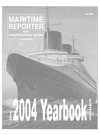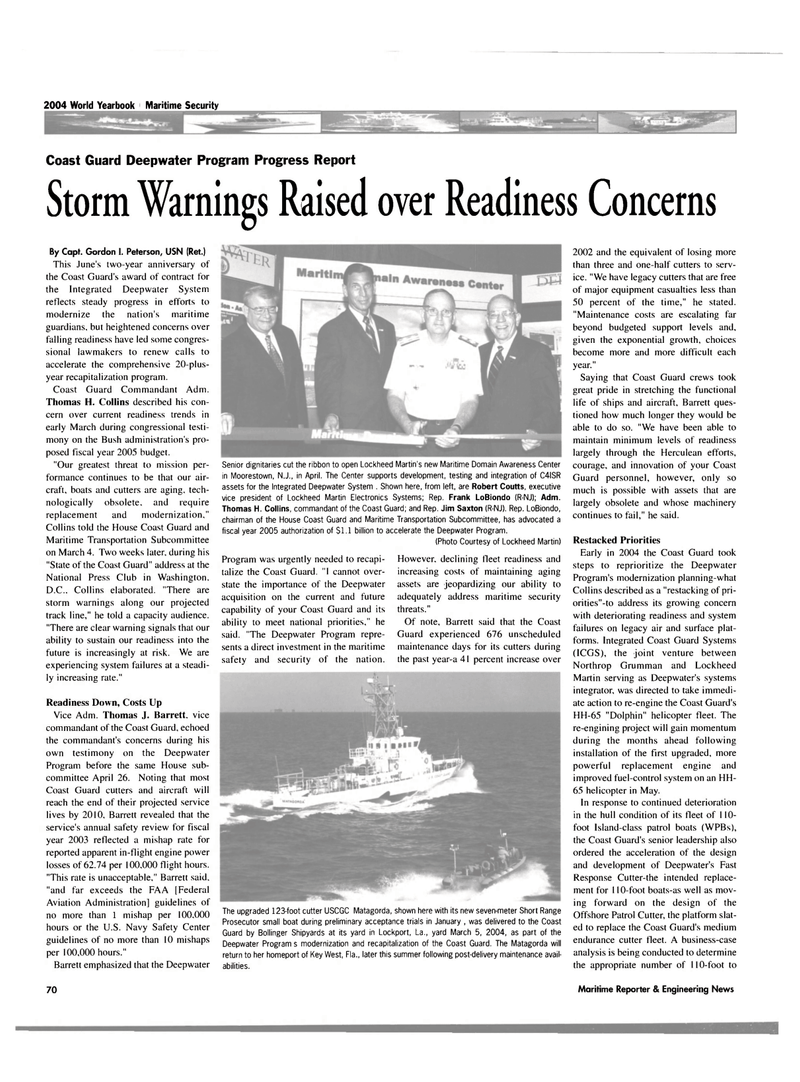
Page 4th Cover: of Maritime Reporter Magazine (June 2004)
Annual World Yearbook
Read this page in Pdf, Flash or Html5 edition of June 2004 Maritime Reporter Magazine
2004 World Yearbook « Maritime Security
Coast Guard Deepwater Program Progress Report
Storm Warnings Raised over Readiness Concerns
By Capt. Gordon I. Peterson, USN (Ret.)
This June's two-year anniversary of the Coast Guard's award of contract for the Integrated Deepwater System reflects steady progress in efforts to modernize the nation's maritime guardians, but heightened concerns over falling readiness have led some congres- sional lawmakers to renew calls to accelerate the comprehensive 20-plus- year recapitalization program.
Coast Guard Commandant Adm.
Thomas H. Collins described his con- cern over current readiness trends in early March during congressional testi- mony on the Bush administration's pro- posed fiscal year 2005 budget. "Our greatest threat to mission per- formance continues to be that our air- craft, boats and cutters are aging, tech- nologically obsolete, and require replacement and modernization,"
Collins told the House Coast Guard and
Maritime Transportation Subcommittee on March 4. Two weeks later, during his "State of the Coast Guard" address at the
National Press Club in Washington.
D.C.. Collins elaborated. "There are storm warnings along our projected track line," he told a capacity audience. "There are clear warning signals that our ability to sustain our readiness into the future is increasingly at risk. We are experiencing system failures at a steadi- ly increasing rate."
Readiness Down, Costs Up
Vice Adm. Thomas J. Barrett, vice commandant of the Coast Guard, echoed the commandant's concerns during his own testimony on the Deepwater
Program before the same House sub- committee April 26. Noting that most
Coast Guard cutters and aircraft will reach the end of their projected service lives by 2010, Barrett revealed that the service's annual safety review for fiscal year 2003 reflected a mishap rate for reported apparent in-flight engine power losses of 62.74 per 100,000 flight hours. "This rate is unacceptable," Barrett said, "and far exceeds the FAA [Federal
Aviation Administration] guidelines of no more than 1 mishap per 100.000 hours or the U.S. Navy Safety Center guidelines of no more than 10 mishaps per 100,000 hours."
Barrett emphasized that the Deepwater
Senior dignitaries cut the ribbon to open Lockheed Martin's new Maritime Domain Awareness Center in Moorestown, N.J., in April. The Center supports development, testing and integration of C4ISR assets for the Integrated Deepwater System . Shown here, from left, are Robert Coutts, executive vice president of Lockheed Martin Electronics Systems; Rep. Frank LoBiondo (R-NJ); Adm.
Thomas H. Collins, commandant of the Coast Guard; and Rep. Jim Saxton (R-NJ). Rep. LoBiondo, chairman of the House Coast Guard and Maritime Transportation Subcommittee, has advocated a fiscal year 2005 authorization of $1.1 billion to accelerate the Deepwater Program. (Photo Courtesy of Lockheed Martin)
Program was urgently needed to recapi- talize the Coast Guard. "1 cannot over- state the importance of the Deepwater acquisition on the current and future capability of your Coast Guard and its ability to meet national priorities," he said. "The Deepwater Program repre- sents a direct investment in the maritime safety and security of the nation.
However, declining fleet readiness and increasing costs of maintaining aging assets are jeopardizing our ability to adequately address maritime security threats."
Of note, Barrett said that the Coast
Guard experienced 676 unscheduled maintenance days for its cutters during the past year-a 41 percent increase over
The upgraded 123-foot cutter USCGC Matagorda, shown here with its new seven-meter Short Range
Prosecutor small boat during preliminary acceptance trials in January , was delivered to the Coast
Guard by Bollinger Shipyards at its yard in Lockport, La., yard March 5, 2004, as part of the
Deepwater Program s modernization and recapitalization of the Coast Guard. The Matagorda will return to her homeport of Key West, Fla., later this summer following post-delivery maintenance avail- abilities. 2002 and the equivalent of losing more than three and one-half cutters to serv- ice. "We have legacy cutters that are free of major equipment casualties less than 50 percent of the time," he stated. "Maintenance costs are escalating far beyond budgeted support levels and, given the exponential growth, choices become more and more difficult each year."
Saying that Coast Guard crews took great pride in stretching the functional life of ships and aircraft, Barrett ques- tioned how much longer they would be able to do so. "We have been able to maintain minimum levels of readiness largely through the Herculean efforts, courage, and innovation of your Coast
Guard personnel, however, only so much is possible with assets that are largely obsolete and whose machinery continues to fail," he said.
Restacked Priorities
Early in 2004 the Coast Guard took steps to reprioritize the Deepwater
Program's modernization planning-what
Collins described as a "restacking of pri- orities"-to address its growing concern with deteriorating readiness and system failures on legacy air and surface plat- forms. Integrated Coast Guard Systems (ICGS), the joint venture between
Northrop Grumman and Lockheed
Martin serving as Deepwater's systems integrator, was directed to take immedi- ate action to re-engine the Coast Guard's
HH-65 "Dolphin" helicopter fleet. The re-engining project will gain momentum during the months ahead following installation of the first upgraded, more powerful replacement engine and improved fuel-control system on an HH- 65 helicopter in May.
In response to continued deterioration in the hull condition of its fleet of 110- foot Island-class patrol boats (WPBs), the Coast Guard's senior leadership also ordered the acceleration of the design and development of Deepwater's Fast
Response Cutter-the intended replace- ment for 110-foot boats-as well as mov- ing forward on the design of the
Offshore Patrol Cutter, the platform slat- ed to replace the Coast Guard's medium endurance cutter fleet. A business-case analysis is being conducted to determine the appropriate number of 110-foot to 70 Maritime Reporter & Engineering News

 3rd Cover
3rd Cover

